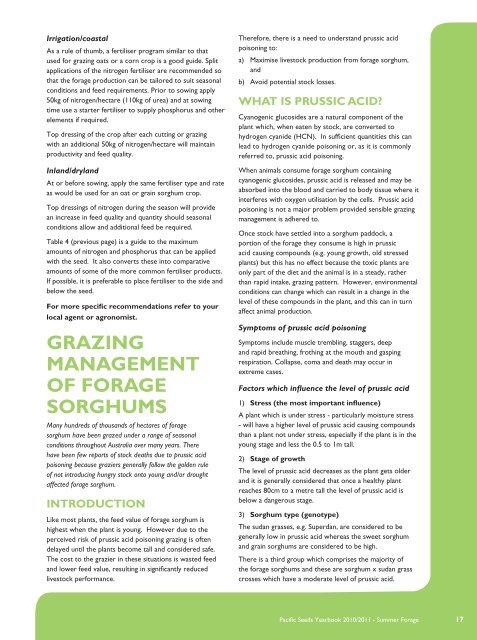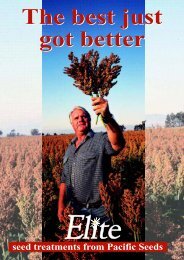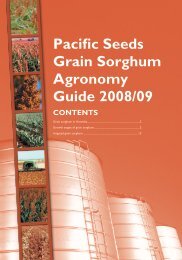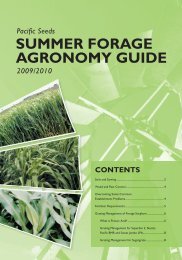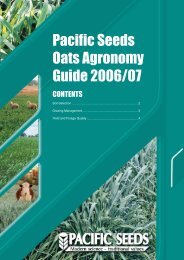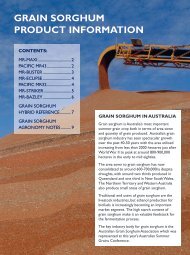SUMMER FORAGE pROdUct inFORMAtiOn - Directrouter.com
SUMMER FORAGE pROdUct inFORMAtiOn - Directrouter.com
SUMMER FORAGE pROdUct inFORMAtiOn - Directrouter.com
- No tags were found...
You also want an ePaper? Increase the reach of your titles
YUMPU automatically turns print PDFs into web optimized ePapers that Google loves.
Irrigation/coastal<br />
As a rule of thumb, a fertiliser program similar to that<br />
used for grazing oats or a corn crop is a good guide. Split<br />
applications of the nitrogen fertiliser are re<strong>com</strong>mended so<br />
that the forage production can be tailored to suit seasonal<br />
conditions and feed requirements. Prior to sowing apply<br />
50kg of nitrogen/hectare (110kg of urea) and at sowing<br />
time use a starter fertiliser to supply phosphorus and other<br />
elements if required.<br />
Top dressing of the crop after each cutting or grazing<br />
with an additional 50kg of nitrogen/hectare will maintain<br />
productivity and feed quality.<br />
Inland/dryland<br />
At or before sowing, apply the same fertiliser type and rate<br />
as would be used for an oat or grain sorghum crop.<br />
Top dressings of nitrogen during the season will provide<br />
an increase in feed quality and quantity should seasonal<br />
conditions allow and additional feed be required.<br />
Table 4 (previous page) is a guide to the maximum<br />
amounts of nitrogen and phosphorus that can be applied<br />
with the seed. It also converts these into <strong>com</strong>parative<br />
amounts of some of the more <strong>com</strong>mon fertiliser products.<br />
If possible, it is preferable to place fertiliser to the side and<br />
below the seed.<br />
For more specific re<strong>com</strong>mendations refer to your<br />
local agent or agronomist.<br />
GRAZING<br />
MANAGEMENT<br />
OF <strong>FORAGE</strong><br />
SORGHUMS<br />
Many hundreds of thousands of hectares of forage<br />
sorghum have been grazed under a range of seasonal<br />
conditions throughout Australia over many years. There<br />
have been few reports of stock deaths due to prussic acid<br />
poisoning because graziers generally follow the golden rule<br />
of not introducing hungry stock onto young and/or drought<br />
affected forage sorghum.<br />
Introduction<br />
Like most plants, the feed value of forage sorghum is<br />
highest when the plant is young. However due to the<br />
perceived risk of prussic acid poisoning grazing is often<br />
delayed until the plants be<strong>com</strong>e tall and considered safe.<br />
The cost to the grazier in these situations is wasted feed<br />
and lower feed value, resulting in significantly reduced<br />
livestock performance.<br />
Therefore, there is a need to understand prussic acid<br />
poisoning to:<br />
a) Maximise livestock production from forage sorghum,<br />
and<br />
b) Avoid potential stock losses.<br />
What is prussic acid<br />
Cyanogenic glucosides are a natural <strong>com</strong>ponent of the<br />
plant which, when eaten by stock, are converted to<br />
hydrogen cyanide (HCN). In sufficient quantities this can<br />
lead to hydrogen cyanide poisoning or, as it is <strong>com</strong>monly<br />
referred to, prussic acid poisoning.<br />
When animals consume forage sorghum containing<br />
cyanogenic glucosides, prussic acid is released and may be<br />
absorbed into the blood and carried to body tissue where it<br />
interferes with oxygen utilisation by the cells. Prussic acid<br />
poisoning is not a major problem provided sensible grazing<br />
management is adhered to.<br />
Once stock have settled into a sorghum paddock, a<br />
portion of the forage they consume is high in prussic<br />
acid causing <strong>com</strong>pounds (e.g. young growth, old stressed<br />
plants) but this has no effect because the toxic plants are<br />
only part of the diet and the animal is in a steady, rather<br />
than rapid intake, grazing pattern. However, environmental<br />
conditions can change which can result in a change in the<br />
level of these <strong>com</strong>pounds in the plant, and this can in turn<br />
affect animal production.<br />
Symptoms of prussic acid poisoning<br />
Symptoms include muscle trembling, staggers, deep<br />
and rapid breathing, frothing at the mouth and gasping<br />
respiration. Collapse, <strong>com</strong>a and death may occur in<br />
extreme cases.<br />
Factors which influence the level of prussic acid<br />
1) Stress (the most important influence)<br />
A plant which is under stress - particularly moisture stress<br />
- will have a higher level of prussic acid causing <strong>com</strong>pounds<br />
than a plant not under stress, especially if the plant is in the<br />
young stage and less the 0.5 to 1m tall.<br />
2) Stage of growth<br />
The level of prussic acid decreases as the plant gets older<br />
and it is generally considered that once a healthy plant<br />
reaches 80cm to a metre tall the level of prussic acid is<br />
below a dangerous stage.<br />
3) Sorghum type (genotype)<br />
The sudan grasses, e.g. Superdan, are considered to be<br />
generally low in prussic acid whereas the sweet sorghum<br />
and grain sorghums are considered to be high.<br />
There is a third group which <strong>com</strong>prises the majority of<br />
the forage sorghums and these are sorghum x sudan grass<br />
crosses which have a moderate level of prussic acid.<br />
Pacific Seeds Yearbook 2010/2011 - Summer Forage 17


